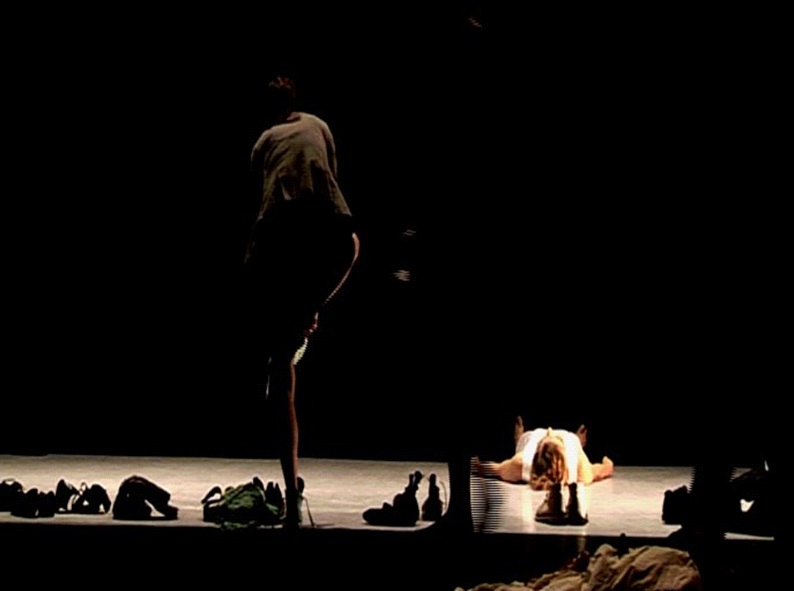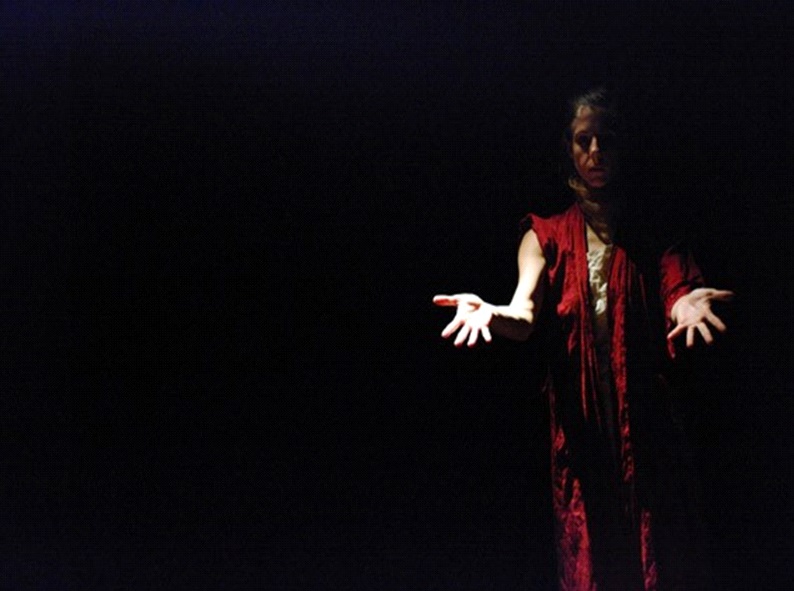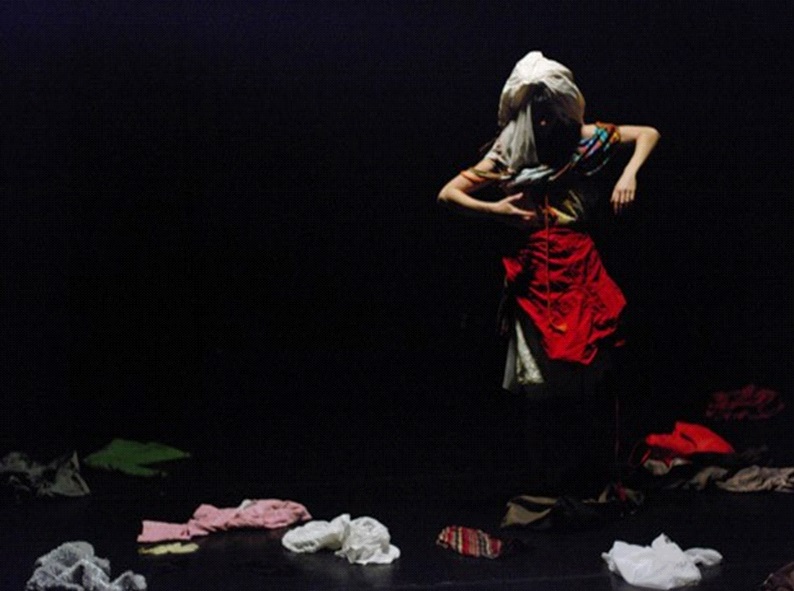One of the ways I experience dance is as a series of body images.‘instilled,’ a solo dance performance (2010) contains many elements that express how I image body, both mine and others. These include images that are visceral, infant-like, in-culturated as woman, as feminine and as a distorted figure of disease. ‘instilled’ was an expression of many elements of my self-body-image without it necessarily
being about me. What follows are excerpts from a major thesis titled: “Vulnerable body: intersecting life, practice and performance” 2010 and developed alongside the performance. There are five descriptive creative reflections from each section of the performance.
Section One: ‘unraveling threads’
Enclosed in the glass foyer reminiscent of shop front displays, surrounded by black paper walls covered with writing (my implicit and imagined history) and dirt covered ground (innate nature), I revealed a multi-layered experiencing of self-image. I slowly revealed the skin of my bare back (explicit body) before disappearing into the blackness of the night/earth. After which the audience were invited to walk through this same room where they were invited to connect with a dialogue between their inner world of perceptual, sensorial and corporeal imaging and the environment they were entering into. In the immediacy of the inter-sensory and inter-corporeal arriving-in-performance there was a heightened awareness of how body images are held within a fluctuating sphere of being as opposed to fixed notions or pre-existing memories.
and no where and somewhere…in between
present and past, in between here and there,
memories and forgettings, life and
death…always sandwiched, never existing
purely because (Strapps 2010)
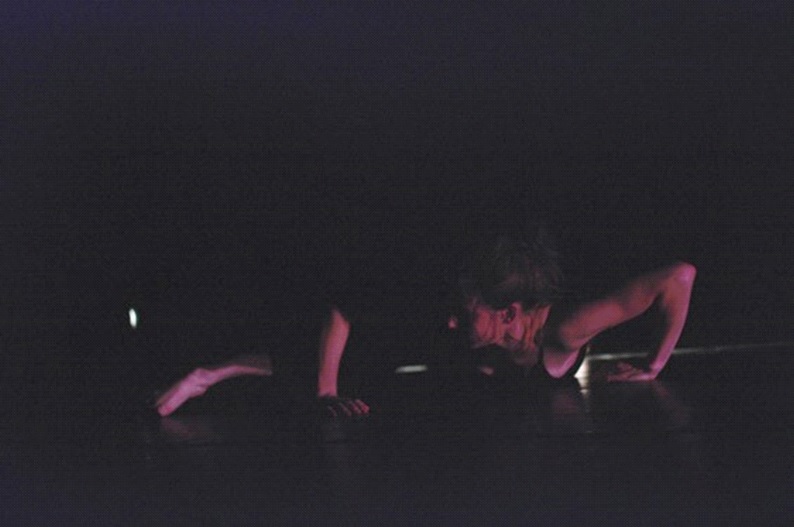
Section Two: ‘nature to culture’
This section was a gathering of knowing that traced a past resonating in the present. I began on the floor, horizontal and at the same level as the audience who sat on cushions on the floor. Lying face down, increasingly visible twitches of muscles, pouring movement into limbs, I assembled into being. The movement was conscious of embodying tensions of being between: horizontal to vertical, still to moving, animal to human, invisible to visible, self and other, past and present. I was conscious of my immediate perceptions and of the images that had accrued and mingled with images from a more distant past.
Section II
My desire for contact with the earth—in both the first and second sections—was grounded by history as much as gravity. It is a desire and a tension I fight to be horizontal – connected to the earth – in a cultural environment that seeks vertical ascension. An evolution into an upright ‘human’ body, arriving into a constructed reality distances its ‘self’ from the earthly weight of the horizontal; of prehistory and the birth-growth-death cycle. Moving along a horizon was to acknowledge our ‘common wordless ground’ (Sheets-Johnstone 1998: 225) that opens into an inter-subjective paradigm for relating to each other in a dialectical experience of between-ness.
A woman alone in her shadow. A woman on display. A
woman who stands facing you but rarely reveals her face.
A woman. A woman who imagines she is all there but
parts of her are somewhere else. A woman haunts herself.
(Strapps 2010)
Section Three: ‘Postures of aging’
‘instilled’ contained certain feminine traces of experience, albeit in subtle material form, which were powerful internal reference points that enliven the present-ness of my performance. In our senses, our energy flow, our organs, our emotions, our imagination and intuitive inklings, our feminine is ever present. This occurred most obviously when I explored my own sense of ageing, putting to one side the stereotypical feminine images. Here I explore shifting my centre of gravity and find
kinaesthetic/images of knees in infancy, shoulders in adolescence, head in maturity, belly in middle age and returning to knees in old age. In much the same way Leder (1990) has observed different cultural postures reflecting centre of gravity within the body. He proposed ‘Most modern Westerners would experience this unequivocally as the head. But the Greeks found this centre within the chest, and the Zen meditator develops the hara, located within the belly, as the wellspring of enlightened experience…’ (1990: 29). These felt-images were of a broader cultural nature, not entirely feminine or masculine but very much housed in my female form.
Section III
To claim my feminine-self, as opposed to feminist or politicised gender construct, is to claim, as Irigaray (1993/2002) does, difference. In doing so, I reclaim womanliness simultaneously a construction of a socially acceptable female body and a feminine state of being that is fragile and strong. Through this combination of cultural construction and innate sensibility I reveal to myself a feminine body that never escapes me.

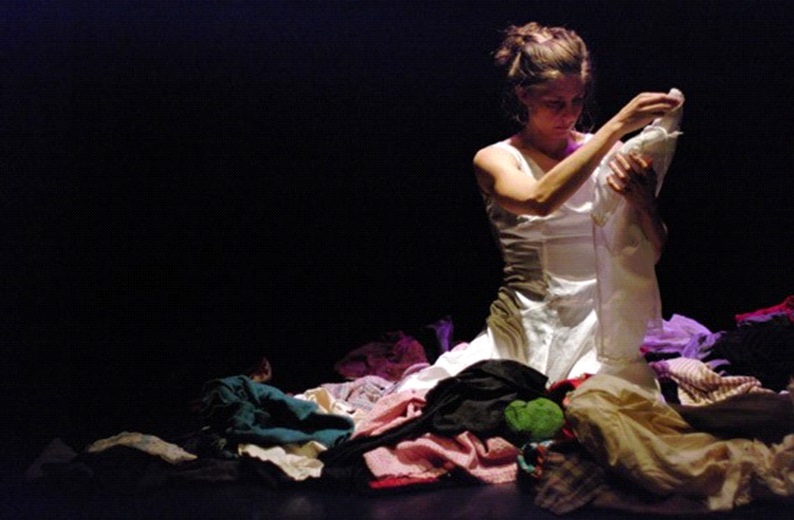
Section Four: ‘exposing vulnerability’
I began to expose the multilayered states of ‘dis’ selves that I self-identified as a complex and cascading experience of disease or dis-formation. Putting on too many clothes served as a metaphor for the implications of being vulnerable and impressionable to the forces of the outside world, effectually becoming dysfunctional. In putting on these layers of clothes – my constructed
selves/roles/identities that I carry daily into my social world – I disrupt the balance between the core self within and the external knowledge-of-self that we internalize. Adopting and wearing these clothes defines me, controls me and eventually distorts me, expressing a growing state of ‘dis’ ease within my body. In between this layering are momentary dances of ‘vulnerable bodies,’ each expressed habits, memories, reflections and impressions of [my]self images.
Section IV
The layering of clothes sequence reflects this distorting body image through painstaking tension and slowness. As I slowly put all the clothes on, I metaphorically layer skins, however, put on wrongly they are rendered useless. Suggesting the consuming and gradually deteriorating nature of dis ease. As the growing restriction intensifies and weighs down my figure, I transform into someone or something other. The clothes also transform into objectified symbols of expired habits, judgments, dreams, pain and unmet expectations.
Section IV: Vulnerable body #2: Habitual
At the end of the fourth section, I shed the clothes to perform ‘crowd body’; a dis-location, collapsing and decaying, striving and interrupting; dancing a letting go of this multiplicity of constructed aspects of self. Like scratching off the infected layers of skin that had become my body through the ‘vulnerable bodies.’ Crowd body is danced until the energy of it exhausts itself. As I reach a point of overcoming my lived objectified pain-filled self, a re-forming occurred. Ending as I had begun, only this time standing, poised and relaxed, empty and yet full of the imprint of the past and the potential of what “I” could now become.
Section IV: Vulnerable body #5: Gathering
From the dance of exhaustion/exhumation comes ‘the speech.’ After a brief silence or, rather the sound only of breath in the darkness, I open my mouth and spurt out a tirade of toxic language, expressing that which had previously been un-utterable. The initial intensity in vocal tone and content is followed by a soft and eventually disappearing voice-body. Expressing a freedom to speak as ‘it’ then ‘she’ then ‘I’ to become, with everyone in the room, nothing but a collective pause in a dark, silent, communal space.
Section Five: ‘thresholds and returning’
From darkness I am slowly revealed lying down in the distance, having returned to a horizon/tal, calm, still and empty of the ‘dis’ tension that has been danced. Lying there, with open eyes, in a state of surrender. This is a moment of respite from all constructs made possible only by going through the tension and subsequent release before it. It is only in stillness that I find an authentic vulnerability necessary to resolve the performance without a finite ending of the work (that is, the standard bow).
Section V
Instead of applause, the audience are invited to contemplate the resonance of the performing space, their place within it and their connection to the performer and each other. The distance between performer and witness diminishes as our worlds blur, as the border between us is re-placed in the moment of returning to the world outside. As I lay on the ground, the audience silently find their own conclusion to the work, having to come towards my still body to locate their shoes now in a line marking the threshold between the black performing space and the white section that leads to the exit. These fragments are by no means absolute and each one contains residues, slippages and layers within the others. However, they are intended to highlight the many different parts of oneself not simply as representation but as expression of bodily presence in dialogue with an ever-transforming environment.
Image Credits: Paul Van Beek
